Here at SEMrush, we believe that creating the most detailed content briefs possible is your best bet if you have something particular in mind that you’re looking for.
We have combined our expertise in content creation, content outsourcing, and product development to provide you with advice and best practices for creating the perfect content brief.
We’ll walk you through the different criteria that we believe should be included in a content brief, and explain how and where to include them to achieve the best result possible. We'll also provide you with a free downloadable brief template that you can use in your upcoming projects.
What You Should Include in Your Content Brief
Content Length
Specifying what you want in terms of content length is important.
But how do you pick the optimal length for your article?
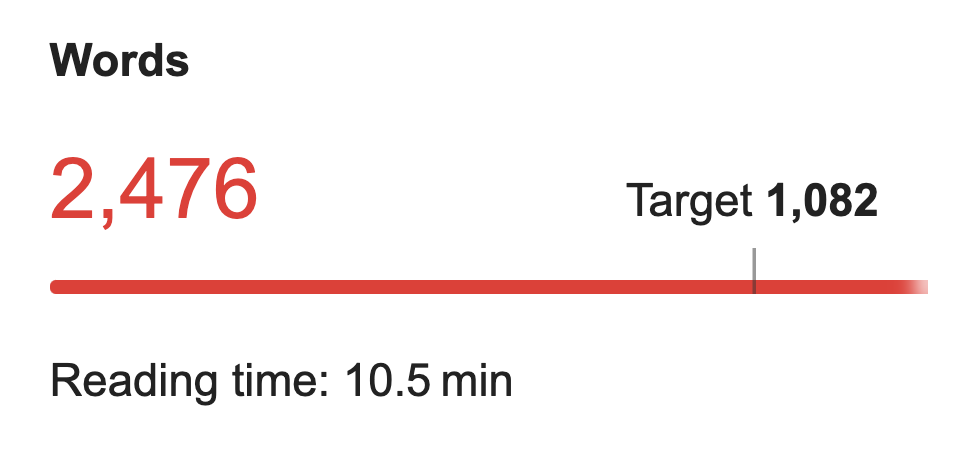
It’s a commonly searched question for anyone who works with content marketing.
Most studies agree that the quality and relevance of content play a far greater role in page rankings than its length.
The average content length for Google’s first page results is around 810 words, according to a 2018 SEMrush study. The same study recommends an average content length of 1137 words for better ranking.
That being said, content length can only be a factor in your page’s success if the content is also comprehensive and focuses on the topic (keyword) you want to rank for.
It also needs to be relevant to satisfy a user’s search query. To ensure this, you need to research your target audience to find out who is going to be consuming your content.
According to the SEMrush Ranking Factors Study 2.0, the optimal content length should correlate with how broad your topic is. The narrower the topic, the longer the read. If you are writing on a broader topic, no one expects you to get into details and produce a long read.
Topic Suggestions
If you don't have a very specific topic in mind, there are several ways to go about finding one.
You can research your audience to find your customers’ biggest pain points by checking out Quora, reviews, and Google’s most asked questions around your rough topic.
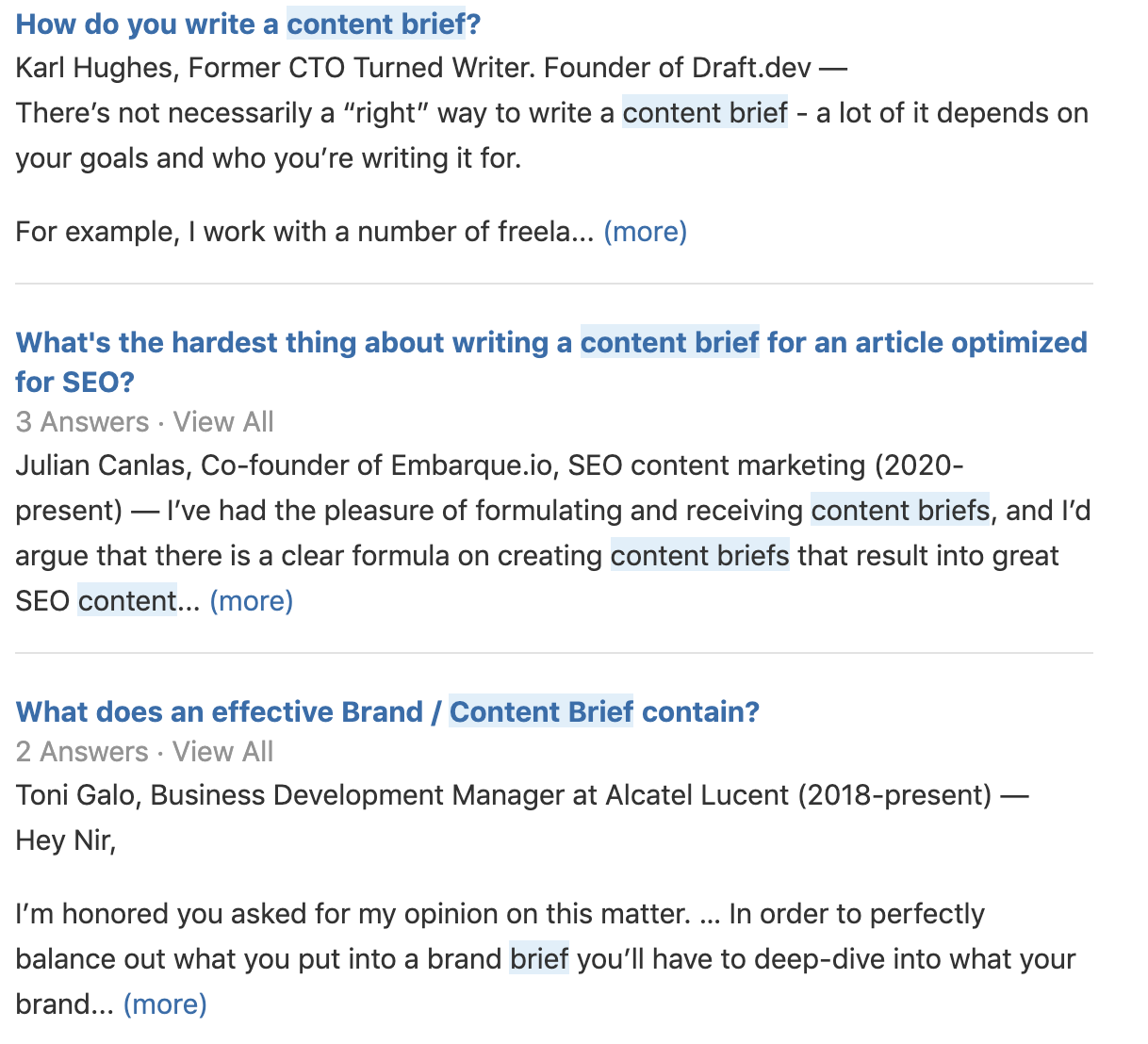
Consider running a survey in your social media about what your followers would love to read about.
Check out your competitors’ content. Carry out a keyword gap analysis to find keywords that your competitors rank for but you don’t. That way, you’ll be able to find topics that your site hasn’t covered.
Repurpose your competitors’ content, making your piece more actionable and valuable.
Use content ideation tools to find the hottest topics that will also rank well.
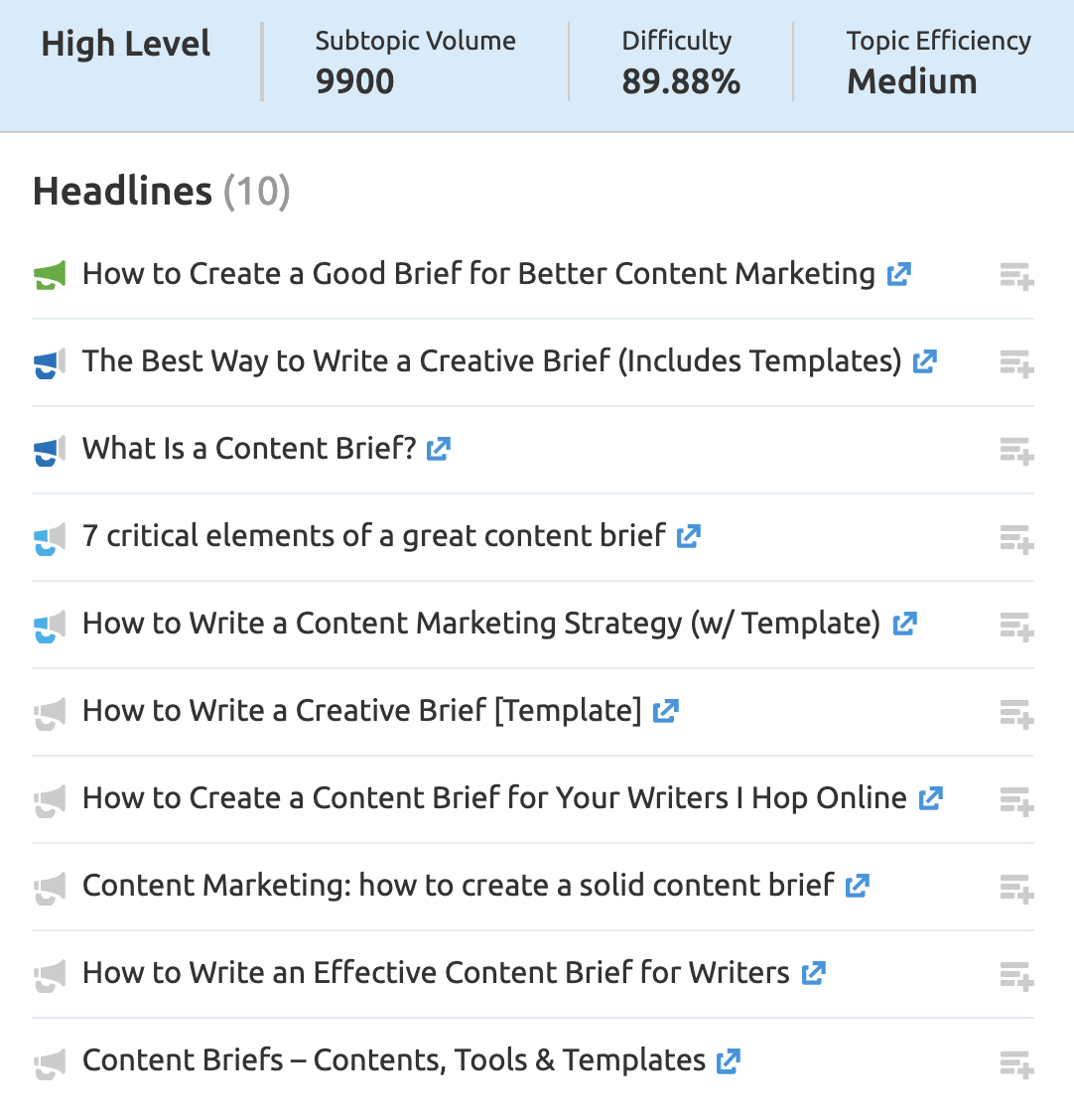
Give your writer the freedom to suggest the topic for you: strong strategic content writers can also offer additional suggestions, based on their experience and research, for how to elevate your idea to the next level.
Keyword Suggestions
Keywords are an absolute must in your content brief. Otherwise, how will a writer know which keywords you want your piece to rank for?
It’s always a good idea to conduct keyword research before you give your writer the list of keywords you want to rank for.
Start by preparing a list of keywords, with your seed keyword at the top followed by long-tail keywords. When searching for long-tail keywords, pay attention to high search volume and CPC, and low SEO difficulty.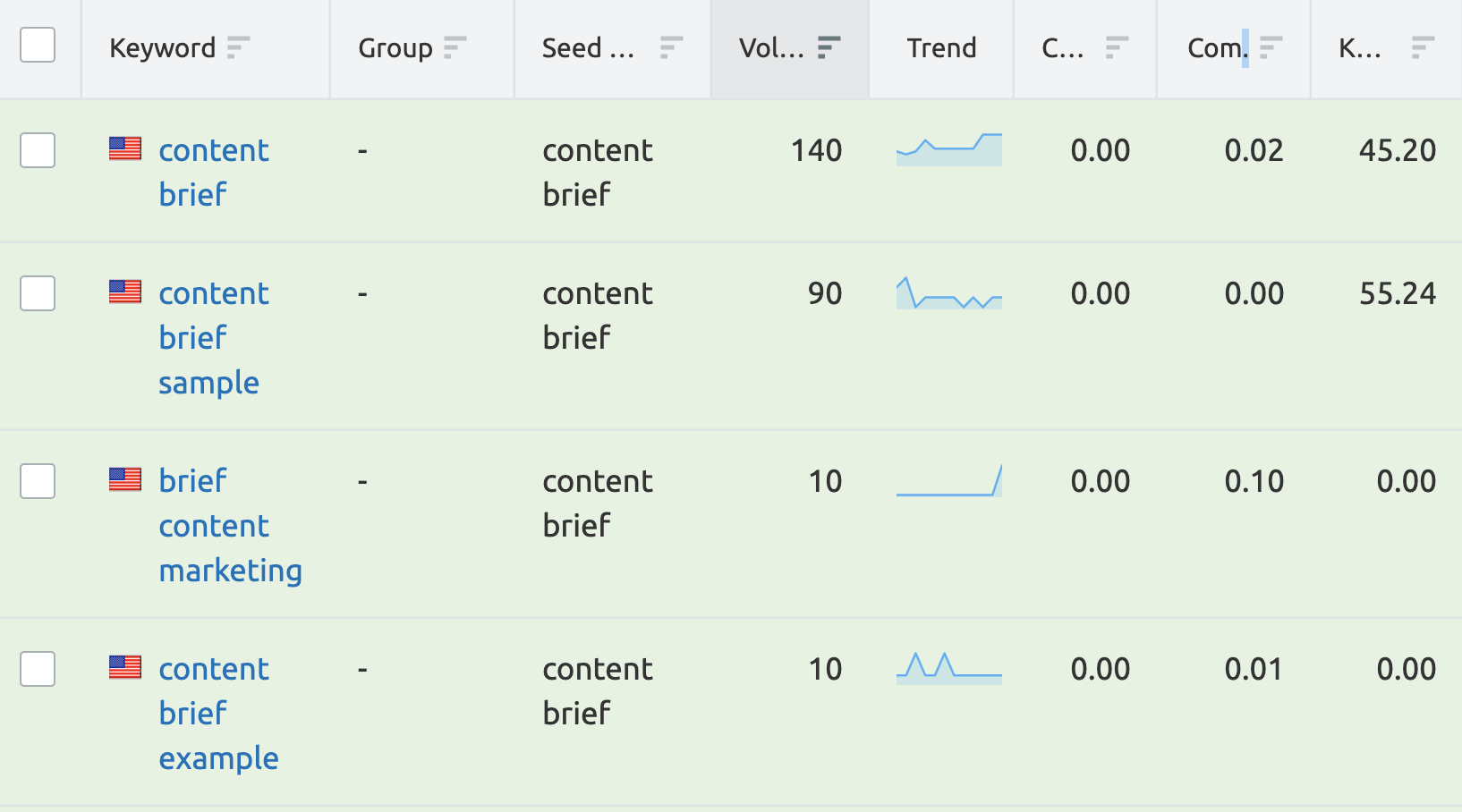
The optimal number of keywords to include in articles is 15, according to the SEMrush study. This gives your article an opportunity to appear in searches for more than just one query.
Be sure to include keyword search volume so that the writer knows which keywords should be used in headings, text body, URL, and meta description.
Remember to give instructions to use the highest-volume keywords in the titles, keywords with average volume in your headings, and those with the lowest volume in your paragraphs. The volume of keywords in your article’s title, headings, and paragraphs should descend accordingly.
You can go ahead and ask the writer to create a URL for the future piece. Keep in mind that an SEO-friendly URL should include your target keyword, and be descriptive and meaningful. Make sure your URL reflects the page title, but at the same time keep it short, around 3 to 5 words.
Tone of Voice
Think about your blog and your brand voice. What type(s) of language do you want to use, and what do you want the overall tone to be?
Is it esoteric and highly technical, designed to appeal to advanced experts in your field? Do you want the content to be fun to read, approachable, and with a sense of humor? Do you want it to feel conversational, or quirky, or strictly professional?
If you’re starting a new blog, take some time to think about who your audience is and how you want to define your brand with your voice. Your audience should always be at the core of your focus, and remember that you can make alterations for audience niches. A school, for example, would likely use two different tones if they were writing for professors instead of students, and a third if they were writing for parents.
The tone matters a great deal, so you want to get this right. Many writers will often ask to see a sample of something that you’ve written, something that’s already on your blog, or a tone that you like from another article online.
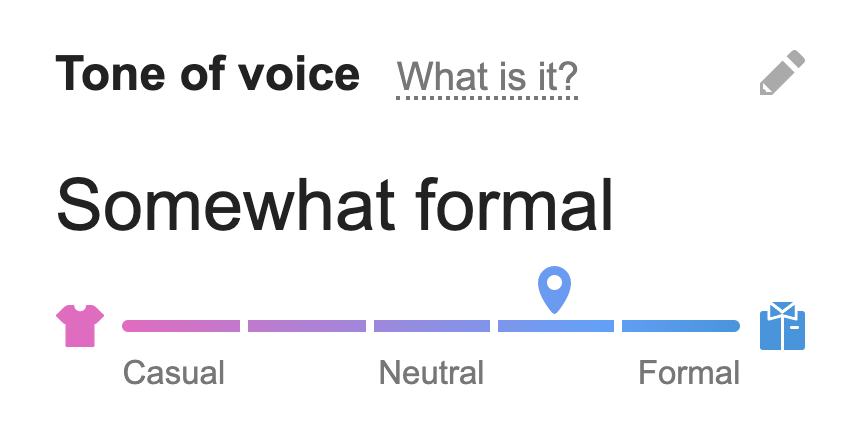
Remember to provide your writer with information about where the content will be published -- the content domain URL -- whether it’s your own blog or an external site. This gives the writer an opportunity to match the new piece in terms of tone and style.
Intended Result
This is a crucial part of a content brief that too many people forget.
What is your goal with the specific piece of content you want the writer to create?
Do you want to create a high-value resource designed to capture high-intent users that are further along in the buying cycle? Think about writing a post like “Five Tricks to Save You Money When Buying a Diamond.” If, however, you want to establish relationships with past customers, go for something like “How to Care for Your Sterling Silver Jewelry.”
Explain what your goal is, so that the writer is fully aware of how they should be pushing your product (if at all). This will also allow them to optimize the post and its CTA accordingly.
For example, if your goal is to increase organic traffic, you need to aim for educational content, with very little mention of your product. If your goal is to collect leads and activate purchases, your content should be more product-oriented and contain a respective CTA (a lead generation form, for instance).
Target Customer
Even if a writer or agency is familiar with your general industry, don’t assume that they’ll know exactly what audience you’re targeting.
A marketing firm might want their writer to create a post about “Google Ads Tricks You Need to Know.” If, however, they don’t tell their writer that they’re focused exclusively on small eCommerce businesses, they could easily end up with a section about service-based ads instead of a more relevant section on Shopping Ads.
No one knows your audience quite as you do, so take the time to make sure that the writer is well aware of who you’re targeting and why.
Consider sharing the following details about your audience:
How they benefit from your service
How they interact with your business
Their niche specifics
Their main pain points
Try to include a buyer persona if applicable.
A strategic writer will shape everything to the specific audience you’re targeting, from their topic and keyword suggestions to the writing style and even the in-post examples.
Links and Statistics
If you only have a few general topic or keyword ideas like “wedding planning tips,” or “choosing a wedding photographer,” that’s okay -- if you’re good with letting the writer run with their research.
If you have more information about what you’re expecting here, though, make sure you mention that. If you want a post on “wedding planning on a budget” and you want the writer to incorporate statistics about wedding planning costs in your region, let them know; don’t just assume that they’ll automatically include this on their own.
And if there are any specific studies, statistics, internal resources, or links to your content or products that you want to be featured, let them know upfront. They can shape the content around this accordingly instead of trying to rearrange everything to stuff it in later on.
Remember that there’s no magic number as to how many links you should have in your article. Add as many links as you believe would be helpful for the user.
Competition
If you’re hiring an agency or a freelance writer, remember that they’ve likely got a decent number of clients on the go, and are working hard to keep up with each one. As a result, they may not be fully aware of exactly who your competition is, and could inadvertently link to direct competitors.
Consider sharing a “don’t link to these brands” list, which details your most prolific competitors. This can save time later down the road.
Examples of Content You Like
Plenty of experienced writers will ask new clients to share examples of work they like. This can be content that you’ve written or content that someone else has written on your blog. It can also be from a direct competitor, or even from another source online with no connection to your industry.
Share at least one or two links to content that you like, and then explain what you like about it. Do you love the tone, or that it’s research-heavy with plenty of statistics? Do you think that it has great hypothetical examples or case studies? Again, the more the writer knows, the better they can deliver what you’re hoping to see the first time around.
Visuals
You can provide your writer with a list of stock image websites that you like and let them choose the most relevant image for your post.
Consider websites like
Unsplash Pixabay Shutterstock iStockPhoto Burst by Shopify Stocksnap Depositphotos CanvaMost stock image websites have on-site filters to help you select the most relevant images. However, it is still recommended that you use two- or three-word phrases to find the closest image to what you’re looking for.
How to Format a Content Brief
Formatting a content brief can feel a little daunting at first, but the best thing to do is to break things down section by section in a shareable document.
It might look something like this:
Suggested Title: How to Write a Content Brief
Target word count: 1500-2000
Audience: small businesses, marketers, and medium-sized businesses who are looking to start outsourcing marketing
Primary keyword: content brief
You can use the structure and framework of the brief moving forward. After the first round, you can just fill in new information as needed, while much of the information may stay the same, including your audience information, brand voice, and language.
Content Brief Template
Having put together all the necessary components of a content brief listed above, the SEMrush team has come up with its own version of the perfect content brief.
Feel free to use our brief template if you don’t have the time to create your own brief -- it is available for free download.
We use it for our Content Marketplace service: before submitting an order for content, a user is asked to fill in the information fields. This service provides high-quality, well-researched, and professionally written content for your blog or website at an affordable price.
Final Thoughts
Creating a strong and strategic content brief is essential to making sure that you get exactly what you’re hoping for the first time.
This is why our Content Marketplace content creation process starts with a detailed brief from the client’s side, and we request that they share as much detail as they possibly can. The more information our writers have, the better your content will be.
Innovative SEO services
SEO is a patience game; no secret there. We`ll work with you to develop a Search strategy focused on producing increased traffic rankings in as early as 3-months.
A proven Allinclusive. SEO services for measuring, executing, and optimizing for Search Engine success. We say what we do and do what we say.
Our company as Semrush Agency Partner has designed a search engine optimization service that is both ethical and result-driven. We use the latest tools, strategies, and trends to help you move up in the search engines for the right keywords to get noticed by the right audience.
Today, you can schedule a Discovery call with us about your company needs.
Source:


![How to Create the Perfect Content Brief [Free Template]](https://allinclusive.agency/uploads/images/how-to-create-the-perfect-content-brief-free-template.svg)


